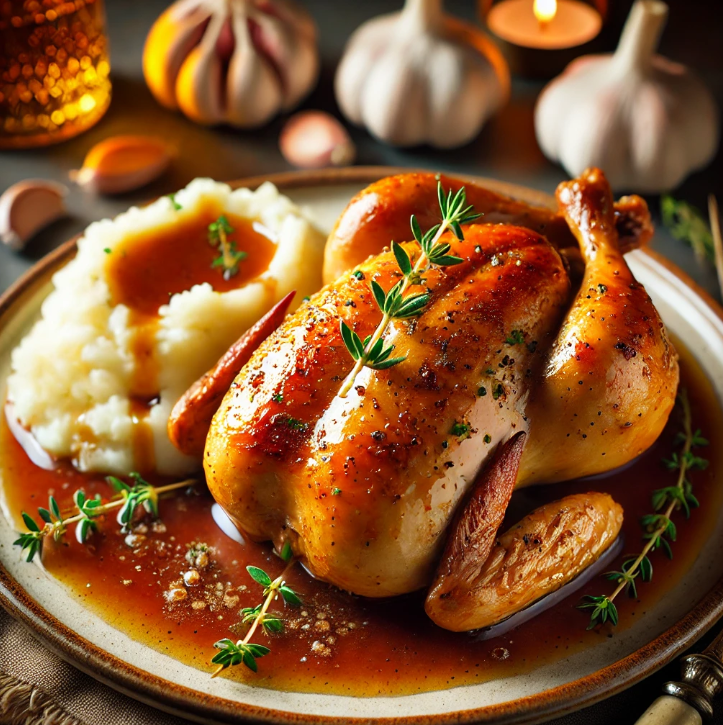Few dishes are as comforting as chicken and gravy. This hearty combination brings together tender, juicy chicken with a rich, savory sauce that’s perfect for pouring over mashed potatoes, biscuits, or rice. Whether it’s a cozy weeknight dinner or a nostalgic meal that takes you back to grandma’s kitchen, chicken and gravy is a timeless favorite that warms both the heart and the soul.
In this guide, we’ll explore everything you need to know about chicken and gravy. From its history and key ingredients to step-by-step instructions for preparing it at home, we’ve got you covered. We’ll also share regional variations, helpful tips, and pairing ideas to help you create the perfect meal.
Table of Contents
What Is Chicken and Gravy?
Defining Chicken and Gravy
At its core, chicken and gravy is a dish that combines cooked chicken—often roasted, fried, or slow-cooked—with a flavorful gravy made from drippings, stock, and seasonings. The gravy serves as the dish’s backbone, enhancing the chicken’s flavor and adding moisture to every bite. Whether served over fluffy mashed potatoes or flaky biscuits, chicken and gravy is pure comfort on a plate.
Why It’s a Family Favorite
What makes chicken and gravy so beloved is its versatility and simplicity. It’s a dish that works just as well for a quick weekday meal as it does for a special Sunday dinner. Plus, it’s endlessly adaptable—you can add your own spin with spices, herbs, or even creamy elements like sour cream. Best of all, it’s budget-friendly, making it a practical option for feeding a crowd without sacrificing flavor.
With its rich, savory taste and universal appeal, it’s no wonder that chicken and gravy has earned its place as a classic comfort food in kitchens across America.
The History of Chicken and Gravy
Origins of Gravy in Cooking
Gravy has been a cornerstone of cooking for centuries, dating back to medieval Europe. It originated as a way to make use of meat drippings, transforming them into a rich sauce that added flavor and moisture to otherwise simple meals. Over time, cooks began adding flour, stock, and seasonings to thicken and enhance the gravy, creating a versatile sauce that could complement almost any dish.
Chicken and Gravy Through the Ages
The pairing of chicken and gravy gained popularity in American kitchens during the 19th century. Early homesteaders relied on simple, hearty meals that made the most of available ingredients, and chicken was often a staple protein. By using the drippings from roasted or fried chicken to make gravy, families could stretch their meals further without wasting a single ingredient.
As Southern cuisine evolved, fried chicken with creamy, peppery white gravy became a signature dish. In the Midwest, baked chicken with brown gravy served over mashed potatoes became a household favorite. Today, chicken and gravy remains a beloved dish across the country, celebrated for its ability to bring comfort and nostalgia to the table.
Essential Ingredients for Chicken and Gravy
The Star Ingredients: Chicken and Drippings
The foundation of chicken and gravy lies in choosing the right chicken. Bone-in, skin-on pieces like thighs and drumsticks are ideal for flavor, as they produce rich drippings that enhance the gravy. For leaner options, boneless chicken breasts work well, especially when paired with additional stock or butter to boost flavor.
Drippings, the flavorful juices left behind after cooking chicken, are a key component of gravy. These drippings contain all the savory goodness needed to create a rich and delicious sauce. If drippings aren’t available, chicken stock or broth can be used as a substitute.
Building a Flavorful Gravy Base
A good gravy starts with a roux—equal parts fat (like butter or chicken drippings) and flour cooked together until golden. This step thickens the gravy and adds a nutty depth of flavor. From there, chicken stock or broth is gradually whisked in to create a smooth, velvety sauce. Seasonings like garlic powder, onion powder, salt, and pepper bring balance and enhance the dish’s overall taste.
Optional Enhancements
For an extra layer of flavor, consider adding fresh herbs like thyme, rosemary, or parsley to the gravy. A splash of cream or a dollop of sour cream can also add richness and create a more indulgent texture.
With these essential ingredients, chicken and gravy becomes a dish that’s as versatile as it is delicious.
How to Make Chicken and Gravy
Preparing the Chicken
The first step in crafting a perfect chicken and gravy dish is preparing the chicken itself. Depending on your preference, you can roast, pan-fry, or slow-cook the chicken. Bone-in, skin-on pieces like thighs and drumsticks are excellent for flavor, as they produce rich drippings that serve as the base for your gravy.
To roast the chicken, season it generously with salt, pepper, and your favorite spices, then bake it at 375°F until the internal temperature reaches 165°F. For pan-frying, lightly dredge the chicken in seasoned flour before cooking it in a skillet with oil or butter. The browned bits left behind in the pan will become the foundation of your gravy.
Making the Gravy from Scratch
To create a velvety gravy, start by making a roux. Combine equal parts fat (from chicken drippings or butter) and flour in a skillet, cooking until the mixture is golden brown. Slowly whisk in chicken stock, ensuring no lumps form. Allow the gravy to simmer and thicken, seasoning with salt, pepper, and aromatics like garlic powder or thyme for a flavorful finish.
For added richness, stir in a splash of cream or a pat of butter before serving. Adjust the consistency by adding more stock if the gravy becomes too thick.
For a similar dish that uses a creamy base, explore creamy chicken and rice.
Variations of Chicken and Gravy
Southern-Style Chicken and Gravy
For a true Southern twist, serve chicken and gravy with fried chicken and creamy white gravy. The white gravy is made using milk, seasoned with black pepper, and thickened with a roux of flour and fat. This combination is a classic comfort food, often paired with buttery biscuits or mashed potatoes.
Healthier and Gluten-Free Versions
If you’re looking for a lighter option, baked chicken with low-fat stock-based gravy is a great choice. For gluten-free variations, replace regular flour with alternatives like cornstarch, rice flour, or arrowroot powder to thicken the gravy. These options deliver the same creamy texture without sacrificing flavor.
Regional Twists
From creamy mushroom gravy to spicy Cajun renditions, chicken and gravy adapts well to regional preferences. Mushroom gravy, made with sautéed mushrooms and onions, adds depth and earthiness to the dish. For those who enjoy bold flavors, Cajun spices like paprika, cayenne, and garlic can transform traditional gravy into something exciting.
For more inspiration, check out this recipe for Chicken and Dressing Casserole to explore another comforting dish!
Pairing Chicken and Gravy with Sides
Classic Pairings
When it comes to chicken and gravy, classic sides are a must to complete the meal. Creamy mashed potatoes are a timeless choice, as they soak up the rich gravy and create a hearty, satisfying bite. Biscuits are another popular pairing—flaky, buttery, and perfect for sopping up every drop of gravy.
Roasted vegetables like carrots, green beans, or Brussels sprouts add a fresh contrast to the dish. Their slightly crisp texture balances the tender chicken and creamy gravy, creating a harmonious plate. For something lighter, consider a simple side salad with a tangy vinaigrette to cut through the richness.
Creative Side Dishes
If you’re looking to mix things up, it pairs wonderfully with polenta or rice pilaf. Polenta’s soft, creamy consistency complements the savory gravy, while rice pilaf offers a textured, flavorful base. For a bolder option, serve it over garlic-infused mashed cauliflower, which is low in carbs but high in flavor.
Cornbread is another fun addition, especially for those who love a sweet-savory combination. Its crumbly texture adds depth to the meal and is especially delicious when paired with Southern-style white gravy.
These pairings elevate chicken and gravy from a simple dish to a well-rounded, comforting meal.
FAQs About Chicken and Gravy
How Do You Make Gravy Without Drippings?
If you don’t have drippings, you can still create a delicious gravy using chicken stock or broth as the base. Start with a roux made from butter and flour, then slowly whisk in the stock. Add seasonings like garlic powder, onion powder, and a pinch of salt to replicate the flavors of traditional gravy.
What’s the Best Chicken Cut for it?
Bone-in, skin-on chicken thighs or drumsticks are ideal for it, as they provide the richest drippings. However, boneless chicken breasts or tenders are excellent options if you prefer leaner cuts.
Can You Make Gravy in Advance?
Absolutely! Gravy can be made ahead of time and stored in an airtight container in the refrigerator for up to three days. Reheat it on the stovetop over low heat, whisking in a splash of stock or water to restore its creamy consistency.
How Do You Fix Lumpy Gravy?
To fix lumpy gravy, simply strain it through a fine mesh sieve or blend it with an immersion blender. Adding warm stock or milk while whisking vigorously can also help smooth out the texture.
What’s the Secret to Perfect Gravy Consistency?
The key to achieving perfect consistency is to add the liquid gradually while whisking constantly. This prevents lumps and ensures the gravy thickens evenly.
Final Thoughts: Why It Is a Timeless Classic
A Comfort Food That Stands the Test of Time
There’s a reason why chicken and gravy continues to be a favorite in kitchens across the world—it’s a dish that combines simplicity, flavor, and nostalgia. With tender chicken and rich, savory gravy, it’s the kind of meal that satisfies both the stomach and the soul.
Endless Opportunities to Customize
Another reason for its enduring appeal is its versatility. Whether you prefer Southern-style fried chicken with creamy white gravy or a healthier roasted chicken paired with a light, broth-based sauce, chicken and gravy can be tailored to suit any taste. By experimenting with spices, herbs, and side dishes, you can make it uniquely yours while keeping the heart of the dish intact.
Perfect for both casual dinners and special occasions, this timeless combination proves that sometimes, the simplest meals are the most memorable.
Creative Serving Ideas for Chicken and Gravy
Transforming Chicken and Gravy into Comfort Food Bowls
Take your chicken and gravy to the next level by creating comfort food bowls. Layer mashed potatoes, shredded chicken, and a generous drizzle of gravy in a bowl, then top with steamed vegetables or sautéed mushrooms. It’s an easy, customizable way to enjoy all your favorite elements in one dish.
Chicken and Gravy Pot Pie
For a cozy twist, use leftover chicken and gravy as the filling for a pot pie. Add vegetables like carrots, peas, and celery, and top with a flaky pie crust or puff pastry. Bake until golden brown for a hearty, crowd-pleasing meal.
Gravy-Topped Sandwiches
Turn chicken and gravy into a satisfying sandwich by layering shredded chicken and gravy between slices of crusty bread or biscuits. For a more indulgent option, try serving it open-faced with a side of fries or coleslaw.
These creative serving ideas highlight the versatility of chicken and gravy, ensuring that this classic dish never gets boring and always delivers comfort.
For more Southern-inspired comfort foods, check out cornbread pudding.
For more delicious ways to prepare Chicken and Gravy and other comforting classics, visit Delish. Their collection of easy-to-follow recipes and cooking tips will inspire you to create mouthwatering meals in your own kitchen!



5 thoughts on “Chicken and Gravy: A Comfort Food Classic”